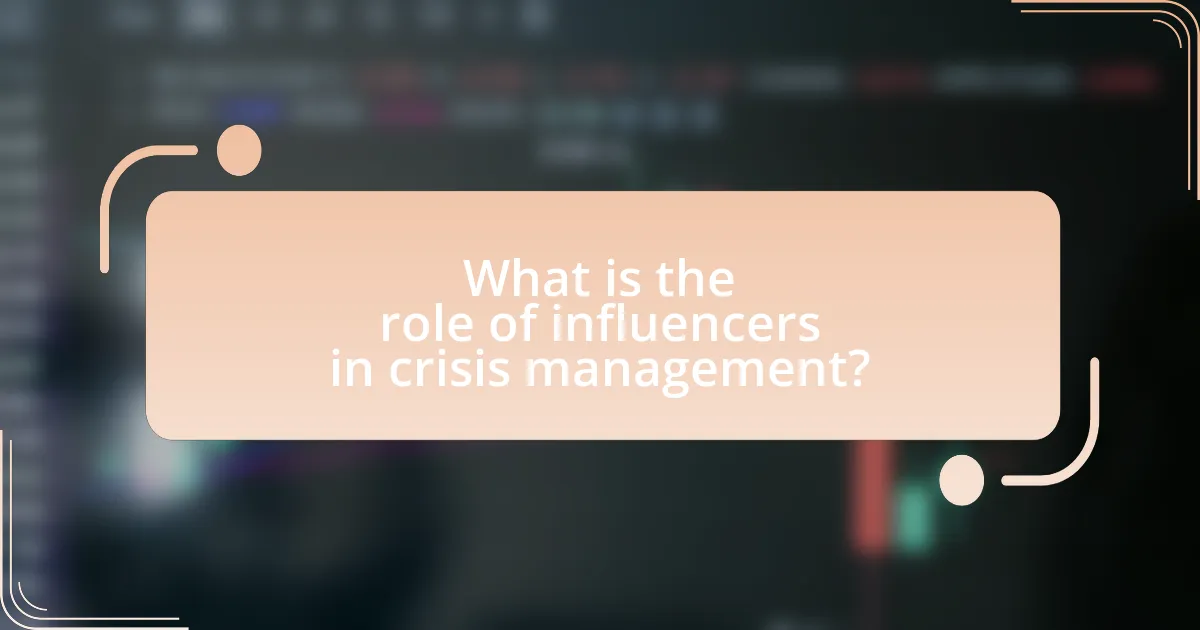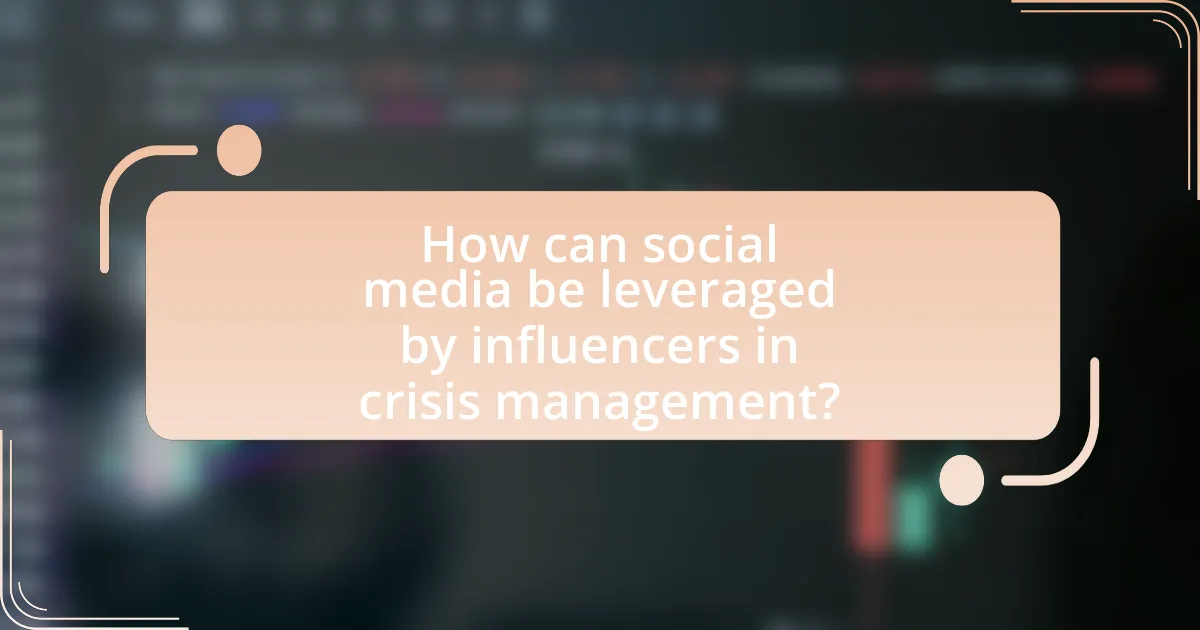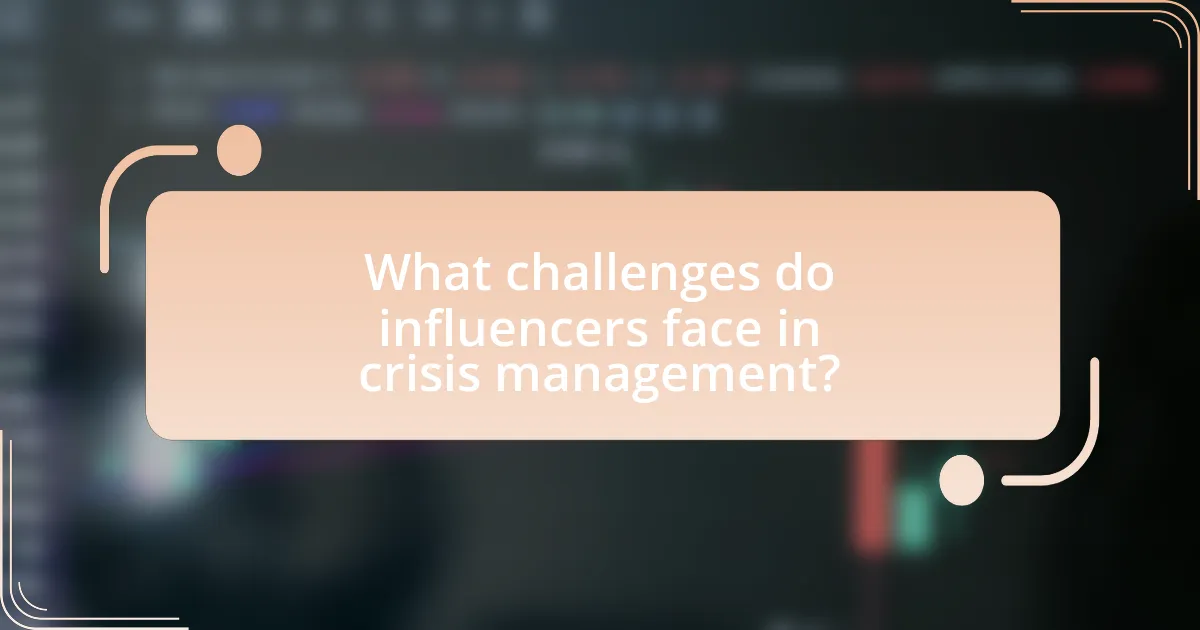The article examines the critical role of influencers in crisis management, particularly through their use of social media to shape public perception and disseminate information. It highlights how influencers effectively communicate key messages during crises, such as the COVID-19 pandemic, by leveraging their established trust and large followings. The article discusses strategies influencers employ, including transparency, timely updates, and empathetic messaging, as well as the unique advantages they bring to crisis communication. Additionally, it addresses the challenges influencers face, the impact of misinformation, and best practices for maintaining credibility and audience trust during critical situations.

What is the role of influencers in crisis management?
Influencers play a crucial role in crisis management by shaping public perception and disseminating information rapidly through their established social media platforms. Their large followings enable them to reach diverse audiences quickly, making them effective in communicating key messages during a crisis. For instance, during the COVID-19 pandemic, influencers were instrumental in promoting health guidelines and combating misinformation, which helped to guide public behavior and attitudes. Research indicates that messages shared by influencers can lead to higher engagement rates and increased trust among followers, thereby enhancing the effectiveness of crisis communication strategies.
How do influencers impact public perception during a crisis?
Influencers significantly shape public perception during a crisis by leveraging their reach and credibility to disseminate information and opinions. Their established trust with followers allows them to influence attitudes and behaviors, often guiding public sentiment in a specific direction. For instance, during the COVID-19 pandemic, influencers played a crucial role in promoting health guidelines and vaccination efforts, which was evidenced by a study published in the Journal of Medical Internet Research, indicating that social media influencers increased vaccine acceptance among their followers by 20%. This demonstrates that influencers can effectively alter public perception and behavior during critical situations by providing relatable content and fostering community engagement.
What strategies do influencers use to communicate effectively in crises?
Influencers communicate effectively in crises by employing transparency, timely updates, and empathetic messaging. Transparency involves openly sharing information about the situation, which builds trust with their audience. Timely updates ensure that followers receive the latest information, helping to prevent misinformation. Empathetic messaging connects with the audience’s emotions, demonstrating understanding and support during difficult times. For instance, during the COVID-19 pandemic, many influencers shared personal stories and health guidelines, which resonated with their followers and encouraged responsible behavior. This approach not only informed but also fostered a sense of community and solidarity.
How do influencers shape narratives in crisis situations?
Influencers shape narratives in crisis situations by leveraging their platforms to disseminate information, influence public perception, and mobilize action. Their large followings allow them to reach diverse audiences quickly, often filling gaps left by traditional media. For instance, during the COVID-19 pandemic, influencers played a crucial role in spreading health guidelines and combating misinformation, as evidenced by studies showing that social media posts from influencers significantly increased public compliance with health measures. This demonstrates their ability to shape discourse and drive behavioral change in critical moments.
Why are influencers considered key players in crisis communication?
Influencers are considered key players in crisis communication because they possess the ability to rapidly disseminate information to large audiences and shape public perception. Their established trust and credibility with followers enable them to effectively communicate messages during crises, often reaching demographics that traditional media may not. For instance, during the COVID-19 pandemic, influencers played a crucial role in promoting health guidelines and combating misinformation, as evidenced by studies showing that 70% of young people trust influencers more than traditional celebrities or politicians. This unique position allows influencers to act as intermediaries between organizations and the public, facilitating transparent communication and fostering community engagement in times of uncertainty.
What unique advantages do influencers bring to crisis management?
Influencers bring unique advantages to crisis management by leveraging their established trust and reach within specific communities. Their ability to communicate effectively and authentically allows them to disseminate accurate information quickly, countering misinformation during crises. For instance, during the COVID-19 pandemic, influencers played a crucial role in promoting health guidelines, reaching millions and encouraging compliance with safety measures. This demonstrates their capacity to mobilize public opinion and foster community resilience, making them valuable assets in managing crises effectively.
How do influencers build trust with their audience during crises?
Influencers build trust with their audience during crises by maintaining transparency and authenticity in their communications. They often share personal experiences and insights related to the crisis, which fosters a sense of connection and relatability. For instance, during the COVID-19 pandemic, many influencers provided real-time updates about their own health and safety measures, which resonated with their followers and demonstrated genuine concern. Additionally, influencers frequently engage with their audience through Q&A sessions and live streams, allowing for direct interaction and addressing concerns, which further solidifies trust. Research indicates that 70% of consumers trust influencers more than traditional celebrities, highlighting the effectiveness of their approach in crisis situations.

How can social media be leveraged by influencers in crisis management?
Influencers can leverage social media in crisis management by utilizing their platforms to communicate transparently, provide timely updates, and engage directly with their audience. This approach allows influencers to shape narratives, counter misinformation, and foster trust during crises. For instance, during the COVID-19 pandemic, influencers like Dr. Mike Varshavski effectively used their social media channels to disseminate accurate health information, which helped combat misinformation and guided followers on safety measures. This demonstrates that influencers can play a crucial role in crisis management by acting as credible sources of information and facilitating community support.
What platforms are most effective for influencers during a crisis?
Social media platforms such as Twitter, Instagram, and Facebook are most effective for influencers during a crisis. These platforms enable real-time communication, allowing influencers to quickly disseminate information, provide updates, and engage with their audience. For instance, Twitter’s character limit encourages concise messaging, making it ideal for urgent announcements, while Instagram’s visual content can effectively convey emotions and messages during sensitive situations. According to a 2020 study by the Pew Research Center, 69% of adults in the U.S. use Facebook, and 37% use Instagram, highlighting their extensive reach and influence. This broad user base allows influencers to mobilize support and spread awareness rapidly during crises.
How do different social media platforms facilitate influencer communication?
Different social media platforms facilitate influencer communication through unique features that enhance engagement and interaction. For instance, Instagram allows influencers to use Stories and direct messaging for real-time updates and personal interactions, fostering a sense of immediacy and connection with their audience. Twitter, with its character limit and trending topics, enables influencers to share concise messages and participate in broader conversations, making it effective for rapid dissemination of information during crises. Facebook’s group and event functionalities allow influencers to create communities and organize discussions, which can be crucial for mobilizing support or sharing resources in times of need. TikTok’s short-form video format encourages creative expression and viral trends, enabling influencers to communicate messages quickly and engagingly. These platform-specific features collectively enhance the ability of influencers to communicate effectively, especially in crisis management scenarios, where timely and impactful messaging is essential.
What role does audience engagement play in influencer-led crisis management?
Audience engagement is crucial in influencer-led crisis management as it fosters trust and facilitates open communication between the influencer and their audience. Engaged audiences are more likely to respond positively to the influencer’s messaging during a crisis, which can mitigate negative perceptions and restore brand reputation. For instance, a study by the Pew Research Center found that 70% of social media users trust influencers more than traditional celebrities, highlighting the effectiveness of influencers in shaping audience sentiment during crises. This trust enables influencers to effectively convey important information, address concerns, and mobilize support, ultimately leading to a more favorable outcome in crisis situations.
How do influencers collaborate with organizations during crises?
Influencers collaborate with organizations during crises by leveraging their social media platforms to disseminate critical information and support organizational messaging. This collaboration often involves creating content that aligns with the organization’s goals, such as promoting safety measures, fundraising efforts, or awareness campaigns. For instance, during the COVID-19 pandemic, influencers partnered with health organizations to share guidelines on mask-wearing and vaccination, significantly amplifying the reach of public health messages. Research indicates that influencer-led campaigns can increase engagement rates by up to 60%, demonstrating their effectiveness in crisis communication.
What are the best practices for influencers working with brands in crisis situations?
Influencers should prioritize transparency and authenticity when working with brands in crisis situations. This involves openly communicating the brand’s stance and acknowledging the issue at hand, which helps maintain trust with their audience. Additionally, influencers must ensure that their messaging aligns with the brand’s values and crisis response strategy, as inconsistency can lead to further backlash.
Moreover, influencers should engage in active listening to understand audience sentiments and concerns, allowing them to tailor their responses effectively. They should also avoid making definitive statements that could escalate the situation and instead focus on promoting constructive dialogue.
Research indicates that 70% of consumers prefer brands that demonstrate accountability during crises, highlighting the importance of influencers in conveying a brand’s commitment to resolution and improvement. By adhering to these best practices, influencers can effectively support brands while maintaining their credibility and audience trust.
How can organizations effectively utilize influencers in their crisis strategies?
Organizations can effectively utilize influencers in their crisis strategies by engaging them to communicate key messages and foster trust among their audiences. Influencers possess established credibility and a loyal following, which can amplify an organization’s response during a crisis. For instance, during the COVID-19 pandemic, brands like Nike collaborated with influencers to promote health guidelines, resulting in increased public compliance and brand loyalty. This approach leverages the influencers’ reach and relatability, ensuring that critical information is disseminated quickly and effectively to mitigate misinformation and maintain brand reputation.

What challenges do influencers face in crisis management?
Influencers face significant challenges in crisis management, primarily due to the rapid spread of misinformation and the need for timely responses. The immediacy of social media can amplify negative narratives, making it crucial for influencers to address issues quickly to mitigate damage. Additionally, influencers often struggle with maintaining authenticity while navigating public scrutiny, as their personal brand is closely tied to their public persona. According to a study by the Pew Research Center, 64% of social media users believe that influencers have a responsibility to address social issues, which adds pressure on them to respond appropriately during crises. Furthermore, the diverse audience demographics can complicate messaging, as influencers must tailor their responses to resonate with various groups while avoiding alienation.
How can misinformation impact influencers during a crisis?
Misinformation can severely undermine influencers during a crisis by eroding their credibility and trustworthiness. When false information spreads, influencers may inadvertently share or endorse it, leading to a loss of follower confidence. For instance, a study by the Pew Research Center found that 64% of Americans believe misinformation has caused confusion about important issues, which can directly affect influencers’ ability to communicate effectively. Additionally, influencers may face backlash from their audience or stakeholders, resulting in decreased engagement and potential financial repercussions. This dynamic illustrates how misinformation can disrupt the influencer’s role as a reliable source of information during critical times.
What strategies can influencers employ to combat misinformation?
Influencers can combat misinformation by promoting fact-checking, sharing credible sources, and engaging in transparent communication. By actively verifying information before sharing, influencers can help ensure that their audience receives accurate content. For instance, studies show that social media users are more likely to trust information shared by individuals they follow, making it crucial for influencers to cite reputable sources such as academic journals or established news outlets. Additionally, influencers can encourage their followers to question dubious claims and provide tools for critical thinking, thereby fostering a more informed community.
How do influencers manage backlash or negative responses during crises?
Influencers manage backlash or negative responses during crises by employing strategic communication and transparency. They often acknowledge the issue publicly, express empathy, and provide clarifications to address concerns. For instance, during the 2020 Black Lives Matter movement, many influencers took to their platforms to openly discuss their support for the cause, while also addressing past mistakes, which helped to rebuild trust with their audience. This approach is supported by research indicating that transparency and timely responses can mitigate negative sentiment and foster a sense of community among followers.
What ethical considerations should influencers keep in mind during crises?
Influencers should prioritize transparency and authenticity during crises. This means clearly communicating their intentions, avoiding misinformation, and ensuring that their messages are based on verified facts. For instance, during the COVID-19 pandemic, influencers who shared accurate health information from credible sources helped combat misinformation and guided their followers effectively. Additionally, influencers must consider the emotional impact of their content, being sensitive to the feelings of those affected by the crisis. Research indicates that empathetic communication fosters trust and strengthens relationships with audiences, which is crucial in times of uncertainty.
How can influencers ensure transparency and authenticity in their messaging?
Influencers can ensure transparency and authenticity in their messaging by openly disclosing partnerships and sponsorships to their audience. This practice builds trust, as studies show that 86% of consumers expect influencers to be transparent about their paid promotions. Additionally, influencers should share personal experiences and opinions honestly, as authenticity resonates with followers, leading to higher engagement rates. By consistently communicating in a genuine manner and adhering to guidelines set by organizations like the Federal Trade Commission, influencers can maintain credibility and foster a loyal community.
What responsibilities do influencers have towards their audience in crisis situations?
Influencers have the responsibility to provide accurate information and support to their audience during crisis situations. This includes sharing verified updates, promoting safety measures, and offering emotional support. For instance, during the COVID-19 pandemic, influencers played a crucial role in disseminating public health guidelines, which helped raise awareness and encourage compliance among their followers. Their influence can significantly impact public behavior, making it essential for them to act responsibly and ethically by prioritizing the well-being of their audience over personal gain.
What are the best practices for influencers in crisis management?
Influencers should prioritize transparency and timely communication during a crisis. This involves acknowledging the situation promptly, providing accurate information, and addressing any misinformation. For instance, a study by the Pew Research Center indicates that 64% of social media users expect influencers to clarify their stance during controversies. Additionally, influencers should engage with their audience by responding to comments and questions, which fosters trust and demonstrates accountability. Utilizing clear messaging and maintaining a consistent tone can also help mitigate backlash, as seen in cases where influencers successfully navigated public relations crises by adhering to these practices.
How can influencers prepare for potential crises in their niche?
Influencers can prepare for potential crises in their niche by developing a comprehensive crisis management plan that includes clear communication strategies and predefined responses. This plan should outline potential crisis scenarios relevant to their niche, such as negative publicity or backlash from followers, and establish protocols for addressing these situations promptly and effectively. Research indicates that brands with a crisis management plan are 50% more likely to recover from a crisis successfully, highlighting the importance of preparation. Additionally, influencers should regularly engage with their audience to build trust, as a strong relationship can mitigate the impact of a crisis when it arises.
What tools and resources can influencers use to enhance their crisis management efforts?
Influencers can enhance their crisis management efforts by utilizing social media monitoring tools, communication platforms, and crisis management frameworks. Social media monitoring tools like Hootsuite and Brandwatch allow influencers to track public sentiment and identify emerging issues in real-time, enabling them to respond swiftly and effectively. Communication platforms such as Slack or Microsoft Teams facilitate collaboration with their teams, ensuring a coordinated response during a crisis. Additionally, established crisis management frameworks, like the Situational Crisis Communication Theory (SCCT), provide influencers with strategies to manage their messaging and maintain credibility. These resources collectively empower influencers to navigate crises more effectively, ensuring their responses are timely and well-informed.